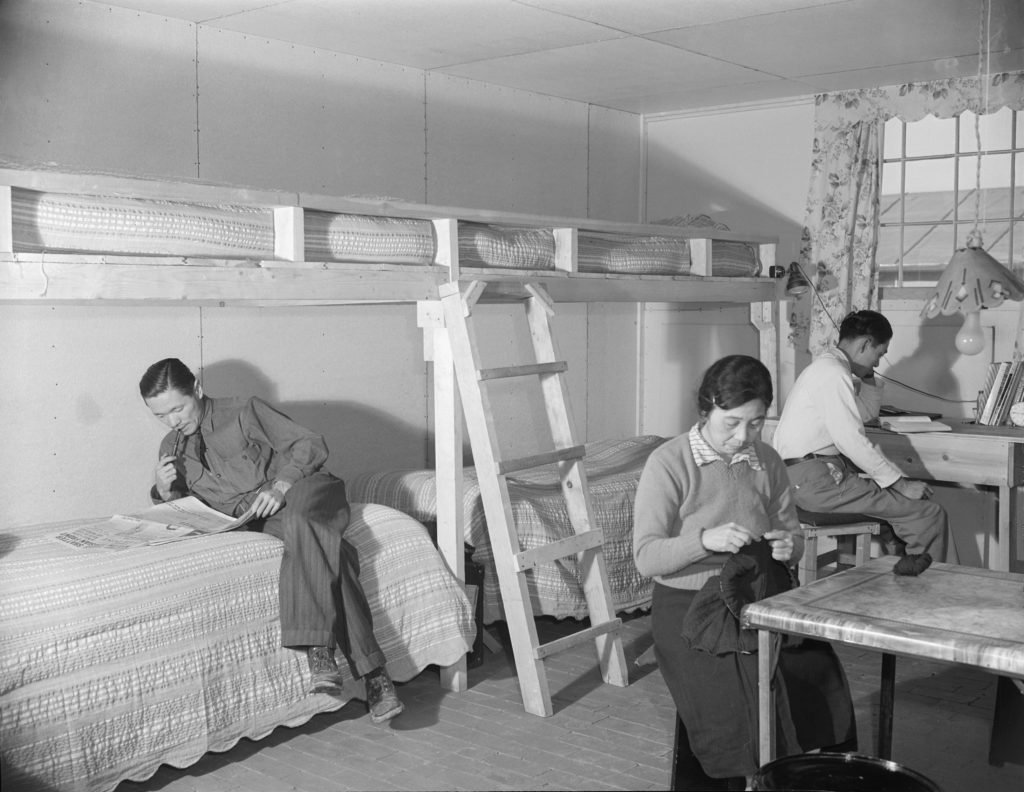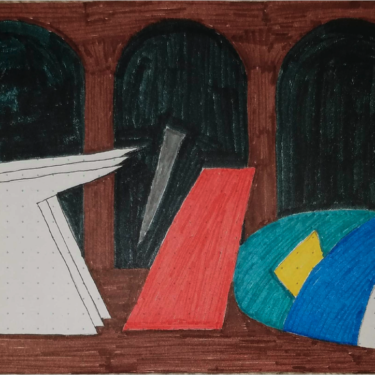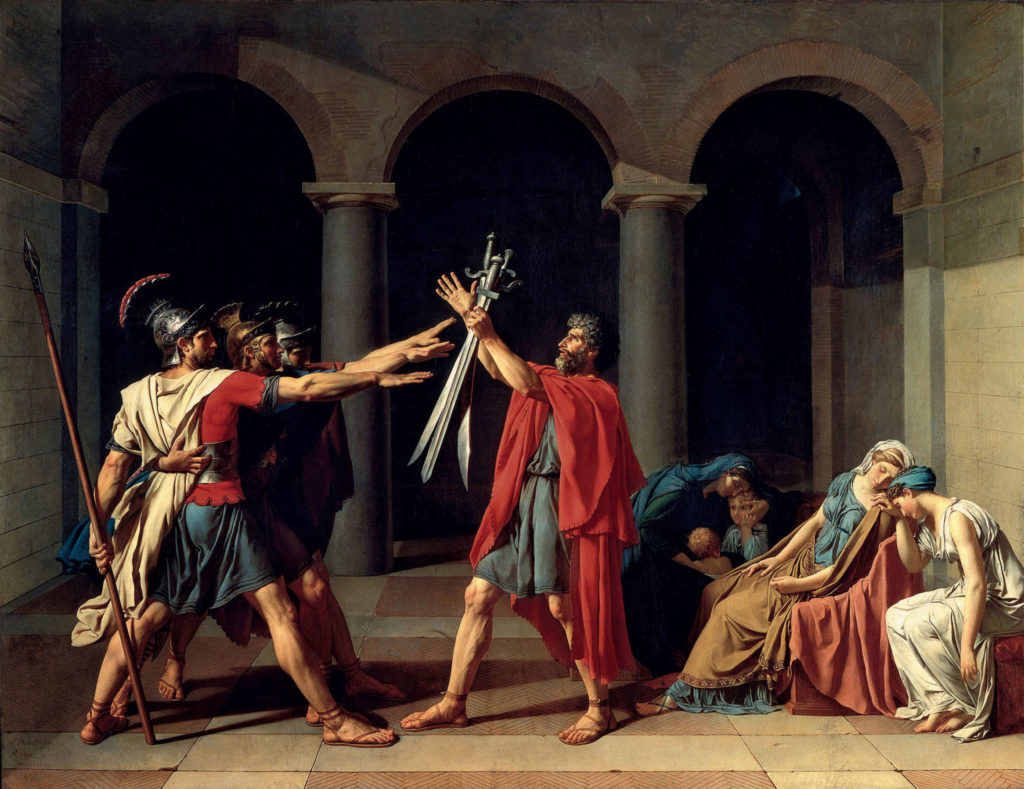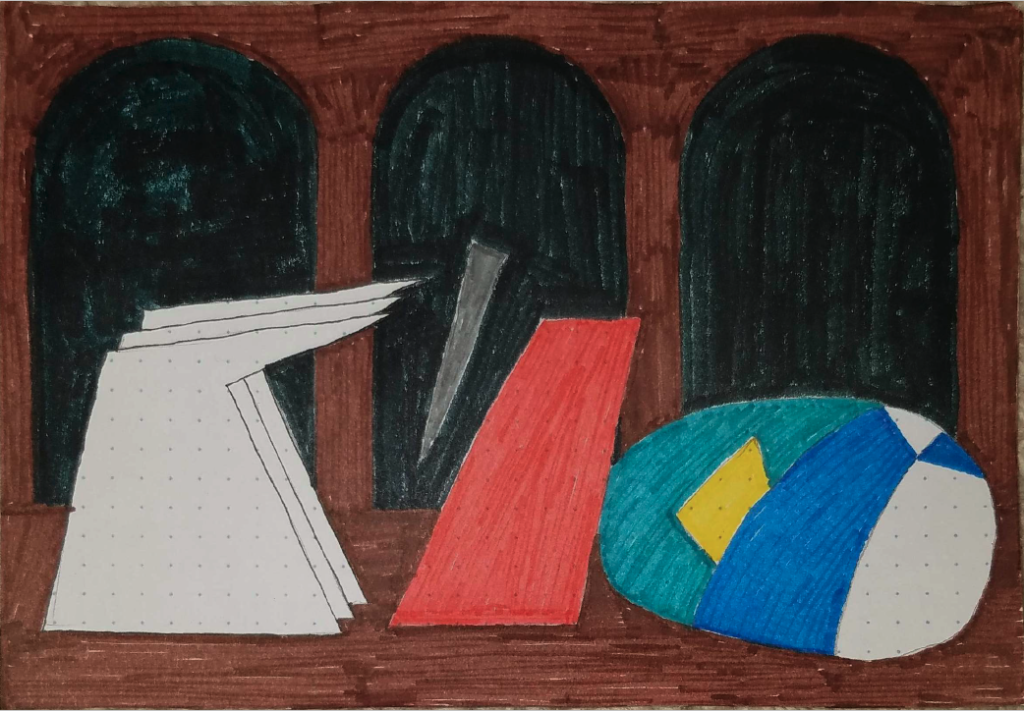I am standing in front of a painting in our campus museum with a group of college students. Smiling broadly, I ask, “What is going on in this painting?” Twenty-five students stare at me blankly, the looks on their faces indicating that they are struggling to intuit what it is that I want to hear. Were they supposed to know this painting already? Many look visibly panicked. My smile becomes slightly strained as a profound silence descends. I’ve had this experience many times, and I wonder, yet again, “What is going on here?”
While remaining present with uncertainty is challenging for everyone, current college students experience heightened anxiety. For them, advancing an untested opinion in front of others feels risky, and risk is something to be avoided.1 Further, research connects risk-aversion to intolerance of ambiguity; the less sure a student is that they have the ‘right’ answer, the more anxious they become when presented with a complex or ambiguous situation.2 Yet, in an era characterized by uncertainty, this generation of students must learn to manage the anxiety that ambiguity provokes and feel empowered to express untested ideas. Economist Noreena Hertz has argued that current college students are facing pervasive “disorder—a combination of the breakdown of old, established orders, and the extremely unpredictable nature of our age.”3 The massive cultural and economic shifts that COVID-19 has wrought in one year provide ample evidence of this unpredictability. As higher education struggles to pivot with rapidly changing 21st-century demands, it is becoming increasingly evident that we must provide students with reliable opportunities to practice taking productive risks and navigating prolonged uncertainty.4
While practice might not make perfect, it does help. In Nonsense: The Power of Not Knowing, Jamie Holmes describes how humans respond to ambiguous circumstances: by actively seeking new information and finding patterns or filtering out incomplete or contradictory information to confirm existing knowledge. The trick is to learn how to lean into the power of the unknown to stimulate new connections while forestalling the tendency to shut down in the face of uncertainty. A key piece is that this takes practice—very few people are born with a well-developed capacity to tolerate prolonged states of not-knowing.5 Importantly, practice doesn’t require confronting large-scale ambiguous problems. In my own experience of developing arts-based learning opportunities for college students, I have repeatedly witnessed the transformative power of often-modest interventions such as VTS to build students’ capacities to confront ambiguity with equanimity, generate novel ideas, and take productive intellectual and personal risks. Research by Professor of Education at Arizona State University, Dr. Ronald Beghetto, supports this observation. While we tend to think that large problems require commensurately large solutions, Dr. Beghetto advocates for “recognizing and capitalizing on the kinds of micro-opportunities that can be leveraged and brought to scale.”6 Micro-opportunities most effectively cultivate students’ capacity to rest productively in the space of not-knowing when they offer moments of what Dr. Beghetto calls ‘structured uncertainty’ in which students confront ambiguous circumstances within a supportive environment.”7 More specifically, VTS provides opportunities for students to engage with actionable uncertainty, “…a state of doubt that rises to a level of awareness whereby we find ourselves at an impasse and feel the need to explore and enact new possibilities.”8 Despite a sometimes painfully-prolonged taxi before takeoff, once the first student tentatively offers an observation, risk-taking becomes less entwined with performance anxiety. As the process unfolds, students internalize the structure of the questions and become increasingly more comfortable. Supportive paraphrasing by the facilitator rewards risk by providing a thoughtful acknowledgment of each student’s unique contribution to the collaborative meaning-making process.9 Driven by students’ observations, supported by a hidden yet reliable structure, and conducted in short, focused sessions, VTS offers precisely the kind of micro-opportunity that helps students explore spaces of not-knowing with confidence.
The unpredictable and open-ended nature of VTS represents a significant risk for facilitators as well: we don’t know what the students will say at any moment, and we must make instant choices about how to respond. Similar to the student experience, when educators embrace the ‘beautiful risk’ of breaking habitual patterns of interaction between students and instructors, new learning possibilities emerge.10 Along similar lines, creativity researcher Dr. Keith Sawyer advocates for what he calls ‘disciplined improvisation’ in teaching by comparing highly effective interactions with students to playing jazz with a group.11 There is an underlying structure, a pattern of call and response embedded in the music that frees musicians to experiment. Similar to the student experience, VTS provides support for instructors to improvise and take risks. What word choices will we make in the paraphrase to reflect students’ comments accurately? When, where, and how often do we ask, “What do you see that makes you say that?” How will we link and frame students’ comments to reveal connections and patterns without declarative analyses? We make these decisions in split seconds, trusting that the VTS structure will support creative, thoughtful, and wide-ranging investigations. We take a risk each time we stand in front of a group of students and hand them the reins by asking, “What is going on here?” By trusting the process and meeting their vulnerability with our own, we make rewarding, creative connections in tandem with the students.
VTS as Creative Problem-Solving
While many creative problem-solving methodologies, such as Design Thinking, are often complex processes that unfold over time, VTS provides an alternative model of an effective problem-solving strategy that can be practiced in smaller increments and integrated across disciplines.12 Students typically approach problem-solving as either a game that concludes when the ‘winner’ arrives at a pre-determined correct answer or as a free-for-all brainstorming session in which all answers have equal weight. VTS offers a corrective to these extremes by guiding students through a balanced process that encompasses creative thinking components: divergence, convergence, and metacognition. Divergent thinking involves generating as many ideas as possible—the more extensive the number and broader the range of ideas, the better. Students practice divergent thinking when we ask, “What more can we find?” By continually asking for ‘more,’ we push students to exhaust all the obvious answers and deny their impulse for “satisficing,” a term in cognitive psychology for stopping the inquiry after arriving at the first satisfying idea. The second question, “What do you see that makes you say that?” invites students to engage in convergent thinking when they find specific, concrete evidence to support an observation. Here, convergence contains self-interrogation: to find evidence for an opinion, students must ask themselves what, specifically, they see that has informed their opinion. This questioning is an example of what Brian D. Kalina has proposed as emergent thinking, an open-ended, metacognitive inquiry that often happens nearly below the consciousness threshold.13 By paraphrasing the student’s evidence without judgment, the facilitator momentarily joins the convergence: the implicit message is, “I hear you, and this is a legitimate way to make meaning.” Creative problem-solving processes of all kinds toggle between these thinking styles until a novel solution is found that derives from a robust and expansive exploration. VTS reflects this circular dynamic in that the discussion doesn’t end after one satisfying diverge/converge circuit. Instead, the facilitator repeatedly re-opens the loop with the third VTS question, “What more can we find?” Rather than asking for further explanations or offering affirming or corrective comments, the facilitator returns the focus to the visual material and encourages additional observations. By repeating this process, the facilitator reinforces the idea that the goal is not to arrive at one definitive interpretation but to generate multiple lines of inquiry. Usually, the time runs out before all possibilities are exhausted. Through this process, ambiguity becomes exciting and rich, rather than frustrating and scary.
In collaboration with faculty in multiple disciplines at Colorado College, I’ve developed activities that incorporate VTS as a creative problem-solving technique that helps students practice their observational skills and then bring those skills to bear on a problem in their discipline.
Case Study: Algebra
The goal of this three-part module, developed in collaboration with the course professor, was to give students tools to navigate a challenging transition from concrete to abstract algebraic functions. We began with a written VTS exercise with Jacques-Louis David’s Oath of the Horatii (1784). After the session, students shared that they were initially apprehensive about offering an incorrect opinion about the artwork. After a few minutes, however, they relaxed into a rhythm and began to enjoy the process. As homework, they completed a short tutorial on creativity theory, which we discussed the following day in the context of their recent VTS experience. Students then practiced problem-solving with VTS using an unfamiliar linear algebra equation provided by the professor. In the last part of the module, students completed a tutorial that began by introducing abstraction in art and concluded with an assignment to create an abstract image based on their VTS observations of Oath of the Horatii. Students later shared their abstractions and discussed how they identified and represented what they believed to be the essential elements of the painting. In the final discussion, the professor first guided students to make associations between abstraction in art and abstraction in linear algebra. We then discussed how the exercise invited students to generate knowledge in one domain (art) that they then applied with a second domain (math). We concluded by discussing how students might apply observation-based creative problem-solving to difficult new course content. At the end of the course, the professor reported that using VTS as an observation-based problem-solving method diminished students’ anxieties and allowed them to bring their creative instincts into their mathematics study. One student summarized the group’s general response to the exercises by expressing frustration with the uncreative ways in which we typically teach mathematics. Like all disciplines, mathematics is an evolving, dynamic field in which opportunities abound for creative discovery. Yet, students must spend most of their education mastering rote systems for solving equations. The majority stop taking math classes before they have a chance to bring their creative intelligence to the discipline.
I have also integrated VTS into courses by positioning it as the first step in a primary source research process. As most primary source research begins with observing an object, experiment, text, or unfamiliar phenomenon, VTS provides a framework for developing initial research questions. While a critical component of scholarship, students don’t usually engage with primary sources until relatively late in their college careers.
Case Study: Psychology
For this psychology course that examines Japanese Americans’ experiences of incarceration in American concentration camps during World War II, I collaborated with the course professor to develop an activity for students to practice attentive looking and creative response as research methodologies. Students first participated in a VTS session on unrelated artworks at Colorado College’s campus museum to practice observing without judgment.14 They drew upon newly- acquired observation skills in a subsequent class session to complete a 15-minute VTS-based written exercise using historical photographs from the camps. In the discussion that followed, students shared what emerged from looking at an image longer than was habitual. A student commented that about half-way through the exercise, she noticed that some people in her photograph were in clearly old, mended clothes, while others wore new clothes. She commented, “I’m not sure exactly what it means, but it seems pretty significant to what is happening.” We discussed how an observation such as this one might lead to new or differently-framed research questions. The final part of the exercise directed students to use their observations to write 500-word monologues from the perspective of a person in the photograph by choosing key details to locate their characterization in specificity. For example, a student noticed how a lounging man on a bed has one foot hovering just above the floor. She thought that, despite his seemingly relaxed posture, this detail indicated he was uncomfortable. She surmised that he might have been assigned to a room with people he didn’t know, and her monologue gave expression to this imagined discomfort. The exercise led to discussions of the benefits and drawbacks of observation and imaginative perspective-taking in the context of research. What can we understand through observation? Where are the gaps in our understandings of what we see? How might close observation, in tandem with imaginative inquiry, help us build research questions to explore those gaps? It is important to note that this exercise occurred within the context of a course in which students regularly addressed racism, abuse, and social injustice. Before the session, the professor had already established a supportive classroom environment where students could discuss and process emotional reactions to challenging material; creating that container is a critical component to this activity’s success.

The Ninomiya family in Grenada concentration camp, Amache, Colorado (1942); photo by Tom Parker, reprinted with permission of Dr. Jim Ninomiya
In a follow-up conversation with the course professor, he expressed that the exercise’s value was twofold. First, the students made connections between the historical narratives they were reading in class and how they might translate into lived experiences. Delving deeply into the photographs’ visual content located this process within the specificity of one piece of the historical story and generated different kinds of questions and associations that the students later brought back into their analyses of the course material. For example, the student writing about the man in the dorm room researched camp living conditions and found that bachelors were sometimes placed in rooms with married couples. Second, writing the monologue from positions outside of the Japanese American incarceration experience illuminated the gaps between knowledge, empathy, and lived experience.
Conclusion
VTS components in the activities presented in this paper invite students to practice specific creative thinking elements: learning to approach uncertainty with curiosity, pushing beyond perceived limitations as they generated multiple ideas about an artwork, and taking social risks to share and explore those ideas. More specifically, sessions that incorporate VTS as a creative problem-solving technique help students develop observational skills that transfer to problem-solving in other disciplines. As observation without judgment comprises an essential component of the creative problem-solving process, higher education must offer students opportunities to develop this capacity. In fact, in their studies of the thinking patterns of a wide variety of artists, performers, academics, and scientists, researchers Robert and Michelle Root-Bernstein have found that sustained observation is the first step to creative thinking and comprises an essential transdisciplinary creative skill.15 Repeatedly inviting students to reflect on their experiences with VTS in the context of developing creative problem-solving capabilities allows them to maximize this capacity for creative transfer. Positioning VTS within the context of creative problem-solving and research processes opens up pathways for students to take risks and engage in creative thinking within courses that may, in other circumstances, only provide rote learning opportunities.16
Questions or comments? Contact us.
Footnotes
- 1 - NESTA, the National Endowment for Science, Technology and Art in the UK, "Learning to Take Risks, Learning to Succeed," Report, 2010.
- 2 - Stress and anxiety can stimulate a strong desire for closure, a phenomenon defined by psychologist Arie Kruglanski as a "desire for a definite answer on some topic, any answer as opposed to confusion and ambiguity." See Webster, Donna M. & Arie W. Kruglanski, “Cognitive and Social Consequences of the Need for Cognitive Closure,” European Review of Social Psychology, 1997; 18: 133–173.
- 3 - Hertz, Noreena. Eyes Wide Open: How to Make Smart Decisions in a Confusing World. New York: HarperCollins, 2013: 9–10.
- 4 - Some evidence exists that interventions to reduce risk avoidance in one context can alter a person’s level of anxiety around risk-taking in other contexts. Maner, Jon K. & Schmidt, Norman B., “The Role of Risk Avoidance in Anxiety,” Behavior Therapy, 37; 2006: 186.
- 5 - Holmes, Jamie. Nonsense: The Power of Not Knowing. New York: Broadway Books, Kindle Edition. 2015: 242.
- 6 - Beghetto, Ronald A., "Leveraging Micro-Opportunities to Address Macroproblems: Toward an Unshakeable Sense of Possibility Thinking," in Creative Intelligence 21st Century: Grappling with Enormous Problems and Huge Opportunities. Ambrose, Don & Sternberg, Robert J. (Eds), The Netherlands: Sense Publishers, 2016: 159.
- 7 - Beghetto, Ronald A., "Structured Uncertainty: How Creativity Thrives Under Constraints and Uncertainty," in Creativity Under Duress in Education?: Resistive Theories, Actions, and Practices. Mullen, Carol A. (Ed.). Creativity Theory and Action in Education Volume 3, Switzerland: Springer Nature, 2019: 34.
- 8 - Beghetto, Ronald A., “Uncertainty,” in The Palgrave Encyclopedia of the Possible. Glăveanu, Vlad. P., Editor. Switzerland: Springer Nature, 2020.
- 9 - Beghetto, Ronald A., “Leveraging Micro-Opportunities to Address Macroproblems: Toward an Unshakeable Sense of Possibility Thinking," in Creative Intelligence in the 21st Century: Grappling with Enormous Problems and Huge Opportunities. Ambrose, Don & Sternberg, Robert J. (Eds), The Netherlands: Sense Publishers, 2016: 162.
- 10 - "Creative openings refer to unexpected breaks in otherwise planned teaching interactions, which result in new and meaningful insights, perspectives and understandings." Beghetto, Ronald A., “Creative Openings in the Social Interactions of Teaching,” Creativity Theories, Research, Applications, 2016; 3(2): 262. See also Beghetto, Ronald A. Beautiful Risks: Having the Courage to Teach and Learn Creatively. Rowman & Littlefield, 2018.
- 11 - Hendriksen, Danah, Mishra, Punya, "Between Structure and Improvisation: on Creativity as a Social and Collaborative Behavior with Dr. Keith Sawyer," TechTrends, 2017; 61:13–18.
- 12 - https://designthinking.ideo.com
- 13 - Kalina, Brian D, “How Might Emergent Thinking Bridge the Gap between Divergent and Convergent Thinking Throughout the Creative Problem-Solving Process?” Big Questions in Creativity 2018: A Collection of First Works, Fields, Kristin Burnett, Cynthia & Mance, Marie (Eds), Buffalo NY: ICSC Press, 2018; 6: 82-90.
- 14 - The Colorado Springs Fine Arts Center at Colorado College Museum integrates VTS into educational activities for the campus and the community.
- 15 - Root-Bernstein, Robert. S. & Root-Bernstein, Michelle. Sparks of genius: the thirteen thinking tools of the world’s most creative people. New York: Houghton Mifflin, 1999.
- 16 - Thank you to Colorado College faculty members Dr. Jason Weaver and Dr. Molly Moran for participating in the case studies; Madison Brookshire, Kabir Singh, and Kris Grey for their thoughtful feedback and assistance in shaping this article; and my eternal gratitude to Creativity & Innovation Director Dez Stone Menendez for her visionary leadership.



